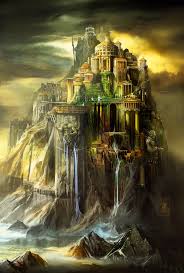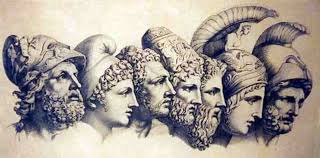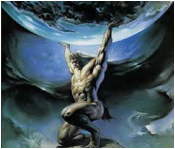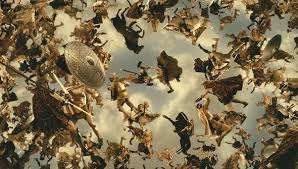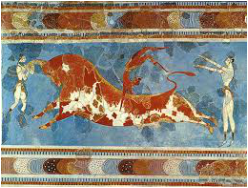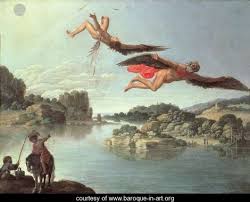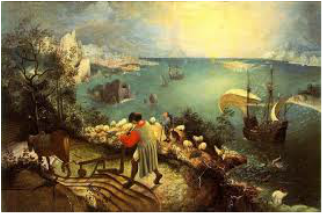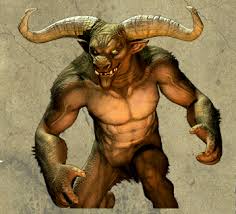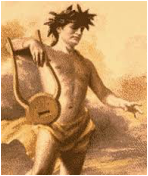|
In Greek mythology, there is no single original text like the Christian Bible or the Hindu Vedas that introduces all of the myths’ characters and stories. Instead, the earliest Greek myths were part of an oral tradition that began in the Bronze Age, and their plots and themes unfolded gradually in the written literature of the archaic and classical periods. The poet Homer’s 8th-century BC epics the Iliad and the Odyssey, for example, tell the story of the (mythical) Trojan War as a divine conflict as well as a human one. They do not, however, bother to introduce the gods and goddesses who are their main characters, since readers and listeners would already have been familiar with them.
Around 700 BC, the poet Hesiod’s Theogony offered the first written cosmogony, or origin story, of Greek mythology. The Theogony tells the story of the universe’s journey from nothingness (Chaos, a primeval void) to being, and details an elaborate family tree of elements, gods and goddesses who evolved from Chaos and descended from Gaia (Earth), Ouranos (Sky), Pontos (Sea) and Tartaros (the Underworld). Later Greek writers and artists used and elaborated upon these sources in their own work. For instance, mythological figures and events appear in the 5th-century plays of Aeschylus, Sophocles and Euripides and the lyric poems of Pindar. Writers such as the 2nd-century BC Greek mythographer Apollodorus of Athens and the 1st-century BC Roman historian Gaius Julius Hyginus compiled the ancient myths and legends for contemporary audiences. Source: "Greek Mythology." History.com. A&E Television Networks, 2011. Web. 08 Sept. 2015. |
Module 1View the Power Points on the Greek gods and goddesses and the lesser gods.
|
Module 2Read the articles on the background of Greek mythology. Be sure to know the intricacies the stories.
|
Module 3View the video on the Greek creation story. Then read an additional story on the second tab.
|
Using the link below, visit the website and complete the assignment concerning the Minoan Civilization. You will only have to provide a username (which is nwilkes) and then type in the "Quick Launch" 177. Complete the directions, read and research activities. From these activities you will be able to fill in the response handout.
|
"The Myth of Daedalus and Icarus"
The myth of Daedalus and Icarus is one of the most known and fascinating Greek Myths, as it consists of both historical and mythical details. While in Crete Daedalus created the plan for the Minoan Palace of Knossos, one of the most important archaeological sites in Crete and Greece today. It was a magnificent architectural design and building, of 1,300 rooms, decorated with stunning frescoes and artifacts, saved until today. The sculpture of Ariadne in Knossos and many others in Elounda and Karia are also his. King Minos and Daedalus had great understanding at first, but their relationships started deteriorating at some point; there are several versions explaining this sudden change, although the most common one is that Daedalus was the one who advised Princess Ariadne to give Theseus the thread that helped him come out from the infamous Labyrinth, after killing the Minotaur. The Labyrinth was a maze built by Daedalus; King Minos wanted a building suitable to imprison the mythical monster Minotaur, and according to the myth, he used to imprison his enemies in the labyrinth, making sure that they would be killed by the monster. Minos was infuriated when found out about the betrayal and imprisoned Daedalus and his son Icarus in the Labyrinth. Icarus was the young son of Daedalus and Nafsicrate, one of King Minos’ servants. Daedalus was way too smart and inventive, thus, he started thinking how he and Icarus would escape the Labyrinth. Knowing that his architectural creation was too complicated, he figured out that they could not come out on foot. He also knew that the shores of Crete were perfectly guarded, thus, they would not be able to escape by sea either. The only way left was the air. Daedalus managed to create gigantic wings, using branches of osier and connected them with wax. He taught Icarus how to fly, but told him to keep away from the sun because the heat would make the wax melt, destroying the wings. Daedalus and Icarus managed to escape the Labyrinth and flew to the sky, free. The flight of Daedalus and Icarus was the first time that man managed to fight the laws of nature and beat gravity. Icarus deathAlthough he was warned, Icarus was too young and too enthusiastic about flying. He got excited by the thrill of flying and carried away by the amazing feeling of freedom and started flying high to salute the sun, diving low to the sea, and then up high again. His father Daedalus was trying in vain to make young Icarus to understand that his behavior was dangerous, and Icarus soon saw his wings melting. Icarus fell into the sea and drowned. The Icarian Sea, where he fell, was named after him and there is also a nearby small island called Icaria. "The Myth of Daedalus and Icarus." Greek Myths Greek Mythology. 2010. Web. 10 Sept. 2015. |
Icarus |
Landscape with the Fall of Icarus-Pieter Breughel
|
Theseus and the Minotaur
|
Read two versions of Theseus and the great fight in the Labyrinth.
|
Watch the videos on the background of the Labyrinth and the Minotaur.
|
Read the story of Orpheus and complete the handout that accompanies it. The handout must be completed in class.
https://www.youtube.com/watch?v=_7CI9RoHVug
https://youtu.be/3Jqgx06TJUM
https://youtu.be/3Jqgx06TJUM
Final Unit Assignment
Choose one of the myths below. Read the myth in class. Compose a two page, MLA formatted paper in which you argue why the story should be considered a myth and how it reflects the cultural beliefs and values of the early Greeks. Be sure to use textual support (either direct quotes or paraphrasing) in your work. Creating the paper in your Google drive document section is the best recommendation for this assignment. Once completed, share the paper at [email protected].
